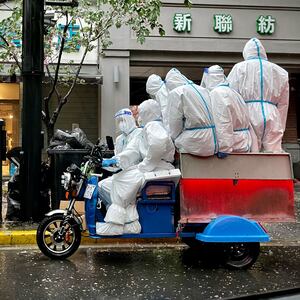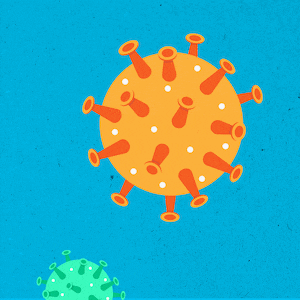COVID cases are going up in many countries as dangerous new subvariants evolve faster and faster. At the same time, individual testing is going down.
That might seem like a dangerous combination. If authorities can’t accurately keep tabs on where and how fast the virus is spread, they might not be able to help protect vulnerable communities.
Fortunately, there’s one way to track SARS-CoV-2 without relying on drive-through testing sites or testing at pharmacies, clinics or hospitals. More and more, scientists are looking for the virus in sewer water. In our toilet flushes, in other words. “Wastewater seems to be the key to early detection, especially in the context of increased at-home testing and potentially reduced reporting,” Niema Moshiri, a geneticist at the University of California, San Diego, told The Daily Beast.
But there’s a big problem with this wastewater surveillance. Any method of monitoring a global pandemic itself needs to be global. While North America, Europe, Australia and parts of Asia have pretty good wastewater surveillance systems in place, China—the country that’s arguably the most vulnerable to COVID right now—doesn’t.
With China’s own individual testing hinging on Beijing’s unsustainable zero-COVID lockdown policy, the country should start shifting to wastewater surveillance, experts explained in a new scientific study. It won’t be easy.
It’s important not to overstate the recent slight increase in global COVID cases. A clutch of highly contagious new coronavirus subvariants—the children of the Omicron variant that first appeared last fall—are driving surges in cases in the United States, South Africa and a few other countries, potentially including North Korea.
Thanks to vaccines and lingering antibodies from past infection, these surges are nowhere near as bad—or as deadly—as previous surges. Amid an overall global decline in COVID, the USA saw an uptick in infections, from a year-low of 30,000 daily new cases in late March and early April to 85,000 daily new cases last week. South Africa meanwhile saw daily new cases rise from 1,300 to 7,700 over the same period.
Hospitalizations and deaths aren’t rising nearly as much, of course—again thanks to all those vaccines and antibodies. What’s perhaps more worrying is the decrease in testing that has tracked along with the increase in infections. At the same time COVID is surging, we seem to be losing our original tool for tracking the disease.
In the U.S., we were testing 2.5 million people every day at pharmacies, drive-through sites, and other locations that reported their test results to state authorities, which in turn reported them to the U.S. Centers for Disease Control and Prevention. Today we’re testing just 55,000 people a day. Individual testing is collapsing in other countries, too.
There’s one very good reason for this drop. At-home tests are now cheap, reliable and readily available. The administration of U.S. President Joe Biden even provides eight free antigen tests per household.
When you test at home, there’s no obligation to report your results to the authorities. It’s possible millions of people all over the world are catching COVID, testing for it, self-isolating and recovering–all without their government knowing it.
Possible, but not likely. In the U.S., for one, the CDC acted quickly back in 2020 to set up a national wastewater-surveillance system that now includes 886 sites spread across the 50 states, tribal lands, and U.S. territories.
Testers scoop water from water-treatment plants, sewers, and septic tanks, test for SARS-CoV-2 and log the results. Sequencing random samples can determine exactly which variants and subvariants are present in a particular community. It was wastewater monitoring that warned us about a regional surge in the BA.2.12 subvariant of Omicron in and around New York starting in late March.
European countries, Australia, and countries across Asia have ramped up their own wastewater monitoring, too. A global surveillance system, one that doesn’t depend on voluntary individual testing, is taking shape.

It’s not perfect, of course. “Wastewater data are meant to be used with other COVID-19 surveillance data,” the CDC stressed on its website.
Wastewater surveillance “doesn’t provide the same degree of localization as clinical testing that is reported,” Rob Knight, the head of a genetic-computation lab at the University of California, San Diego, told The Daily Beast. “The Point Loma wastewater treatment plant in San Diego covers 2.3 million people, so you don’t know if the signal comes from specific areas as you would with clinical testing.”
However, home tests that are not reported don’t provide any public health information at all, so wastewater is better than that.”
The bigger problem is China. Not only do China’s 1.4 billion people account for 18 percent of the world’s population, China is more vulnerable to COVID than most countries. The Chinese government’s zero-COVID policy, which locked down city after city to prevent the virus from spreading, had a tragic side-effect.
For more than two years, almost no one in China caught COVID, meaning almost no one in China had natural antibodies when the extremely contagious Omicron variant and its subvariants showed up—and punched right through citywide lockdowns in Hong Kong, Shenzhen, and elsewhere. It didn’t help that the Chinese government has pushed locally made vaccines that might not be as effective as the best Western-made messenger-RNA jabs.
Daily new cases in China peaked at 30,600 back in late April. They’ve since dropped to fewer than 10,000. But much of China remains locked down. And as long as that’s the case, individual testing isn’t really a problem. Health authorities in major cities can mandate and enforce frequent testing at government-run sites.
But experts agree: China’s zero-COVID strategy is unsustainable. Besides being very unpopular with many Chinese, it’s also driving down China’s economic growth and risking recession in China as well in countries that rely on trade with China.
If and when zero-COVID ends, individual testing in China could collapse the same way it’s collapsed in other countries. And there isn’t a countrywide wastewater monitoring system to pick up the slack in data. Yet. “To cope with the future challenges in public health emergencies, it is vital to monitor sewage,” a team led by Ying Zhang, an environmental engineer at China’s Fuzhou University, explained in a new academic study.
Part of the problem is that, for all its rapid economic growth over the past generation, China is still a developing country—and its development is uneven. That’s apparent in the sewer system. “The allocation of the pipeline across the whole country is unbalanced,” Ying’s team wrote. Drainage is concentrated in the industrial east at the expense of the rural west, leaving potential gaps in surveillance.
And the pipes that do exist aren’t always well-built. “Because the operation, management and maintenance of the drainage system have not drawn much attention in China, serious problems within the drainage system occur in many cities, such as leakage, overflow and blockages.” Blocked and leaky pipes can corrupt samples.

In light of the challenges, Ying and his coauthors proposed starting small with a partial surveillance system in the biggest cities—and expanding from there, as infrastructure allows. In any event, China needs to do something to get ahead of a possible drop in individual testing.
The pandemic isn’t over. New variants and subvariants are coming. If we’re not going to get tested at the corner pharmacy, then we need someone to monitor our pipes. And this needs to happen all over the world.








